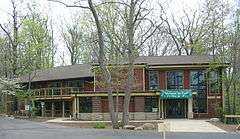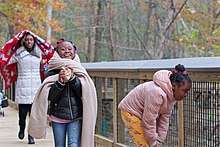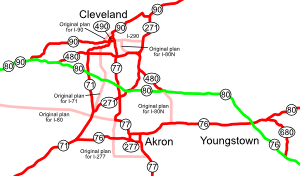Nature Center at Shaker Lakes
The Nature Center at Shaker Lakes is a nonprofit organization in Shaker Heights, Ohio that works to conserve a natural area, educate visitors about nature, and promote better environmental stewardship. It was founded in 1966 as the result of a volunteer effort to preserve the Shaker Parklands from becoming the route for a new freeway connecting Cleveland's East Side to downtown.

The Nature Center offers curriculum-related school programs, including an early childhood program for several East Side school districts and the Cleveland Public Schools. Walkers, runners, and bird-watchers use the trails for exercise and recreation.
The center is home to many wildlife and plant species living in a variety of natural habitats, including marsh, brook, field, forest, and ravine.
The Shaker Lakes

The Shaker Lakes are a system of parklands, connected to the Doan Brook Parklands, through which the Doan Brook runs. The Shaker Lakes Park is a natural and semi-wild area located at the intersection of three municipalities. It includes two lakes created by the Shakers at the North Union Shaker community when they dammed Doan Brook to power their industries. The swamp and woodland areas constitute a small wilderness in the heaviest concentration of population in Ohio, making it available for study and recreation. It is available to people of Greater Cleveland year-round for walking, photography, painting, nature study, rest and family recreation. The Nature Center at Shaker Lakes does not manage Horseshoe or Lower Lake.
The Nature Center serves much of Cleveland's East Side including the Shaker Square and Buckeye neighborhoods. It also serves eastside suburbs of Cleveland including Shaker Heights, Cleveland Heights, University Heights, East Cleveland, Beachwood and South Euclid.
Programs and Volunteer Opportunities
The Nature Center at Shaker Lakes provides students with school field trips, year-round Outdoor Adventure Camps, and outdoor classes and other educational nature-centric events and programs, including the annual Nature at Night benefit.

The Nature Center at Shaker Lakes offers a wide range of opportunities for volunteers ages 13 and up. Environmental stewardship events are held throughout the year to help conserve and preserve the property's 20 acres of natural, native species.
Nature Center Facilities
The Nature Center at Shaker Lakes has indoor and outdoor facilities open to the public and is available for rentals, including birthday parties, weddings, and more. It houses classrooms, a meeting room, exhibit areas, a library, and The Duck Pond, a nature-themed gift store. The Jean Eakin Bird Observation Station, the Murphy Carfagna Wildlife Balcony and a gallery overlook the grounds. There is also an outdoor pavilion, the All People's Trail, and Stearns Woodland Trail in the woodlands surrounding the Nature Center. The 0.4 mile long All People's Trail is a barrier-free, elevated boardwalk, designed to be ADA accessible for visitors with all physical abilities. A new All People's Trail was constructed in the fall of 2019 and is now open to the public. Features include a whimsical hand-crafted Rose Foundation Gazebo and wider boardwalk with wildlife viewing areas for classes and gatherings. The Stearns Woodland Trail is one-mile long and begins at the Nature Center's Wildflower Garden. The trail runs through several wooded, native habitats along the south branch of Cleveland's Doan Brook.

History

In 1896, the Shaker Lakes Park was deeded to the Doan Brook Park Commission to become part of the park system which included Ambler, Wade, Rockefeller and Gordon Parks. In 1915, the deed transferred to the city of Cleveland by order of the Ohio Supreme Court. In 1947, the Shaker Lakes Park was leased to the cities of Shaker Heights and Cleveland Heights for the portions of the park falling within their boundaries. 1964 and '65 saw the proposal for construction of the Clark Freeway and Lee Freeway which would provide a more direct route from downtown Cleveland to Interstate 271. The Clark Freeway would run through the park on either side of the Doan Brook. The intersection of the proposed Clark and Lee freeways would have intersected right where the Nature Center stands today.
An effort to oppose the freeway was led by the Park Conservation Committee and 35 garden clubs and six civic organizations. An overall committee, the Committee for Sane Transportation and Environmental Policy (CSTEP) was formed and developed several strategies. These included walks for officials and residents through the parklands, discussions with schools in the surrounding communities about the need for nature education, an effort to get citizens to write letters and protest the construction of the freeway and the commissioning of an Audubon Report about the feasibility of a nature center. The Audubon appraisal concluded that, "For the study of conservation and nature in an outdoor laboratory, there is no comparable area to the park within the limits of Greater Cleveland."
In the summer of 1966, recreation programs were held in the lakes area and funding was given to continue with a naturalist for school classes in the fall. On September 15, 1966, The Shaker Lakes Regional Nature Center was formed and incorporated, and fundraising began for the establishment of a building. A lease and permission to build the center was negotiated with the City of Cleveland, while the Park Conservation Committee simultaneously worked toward getting the Center designated as a National Environmental Education Landmark. In 1970, a meeting was held at Shaker Heights Middle School with a presentation to Governor James Rhodes about the proposed freeway. Rhodes subsequently directed that the route for the Clark Freeway be withdrawn from the Interstate System.
Maxwell Norcross, an architect in Cleveland from 1923 to 1970 and a member of the Shaker Heights architectural board designed the nature center. The building was paid for largely through individual contributions and was completed in November 1969. Gary Nelson was hired as the first full-time director in 1971. That same year, the Stearns Memorial Nature Trail and the Wildflower Garden were constructed with contributions from the Shaker Lakes Garden Club. In 1973, the building was remodeled to create additional office and library space. In 1982, the All People's Trail was constructed, followed by the redesign of the Stearns Memorial Trail and the addition of an East Wing in 1985. In 2003, the Nature Center used sustainable building practices to renovate and update its indoor facilities to include upgraded and expanded classrooms, community meeting rooms, a nature experience area, a bird observation station, and the gift shop.
.jpg)
Designations
The Nature Center was named a National Environmental Education Landmark in 1971 by the National Park Service of the United States Department of the Interior, making it one of the first organizations to be recognized as such. It is also designated as a National Environmental Study Area by the Park Service for the unique educational opportunities offered by the diverse natural habitats found in its urban setting. In 2003, the Audubon Society designated it as a worldwide Important Bird Area. After renovating and expanding its facilities in 2003 using sustainable building practices, the Nature Center received the U.S. Environmental Protection Agency’s 2004 Energy Star Award for Excellence in Energy Efficiency. In 2006, the Nature Center was certified as an official Wildlife Habitat site by the National Wildlife Federation. The Nature Center is also listed on the National Register of Historic Places.
Further reading
- Pacini, Lauren R.; Peskin, Laura M. (2016). Preserving the Shaker Parklands: The Story of the Nature Center at Shaker Lakes. Cleveland, Ohio: Artography Press. ISBN 9780692750353.
- Gooch, Laura C. (2001). The Doan Brook Handbook: A Guide to the Shaker Lakes, Rockefeller Park, the Cleveland Cultural Gardens, and Points Between. Cleveland, Ohio: The Nature Center at Shaker Lakes. ISBN 9780970910806.